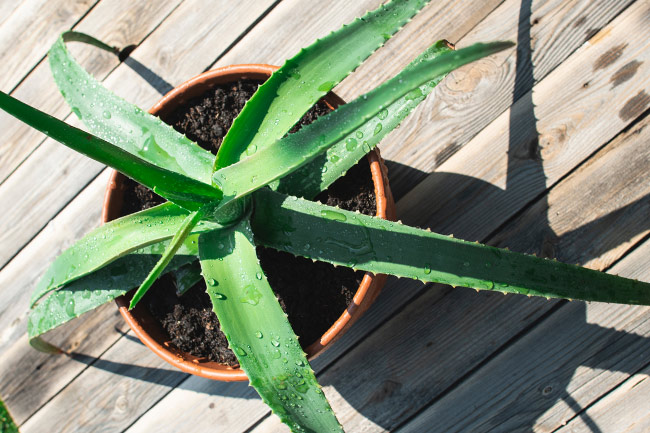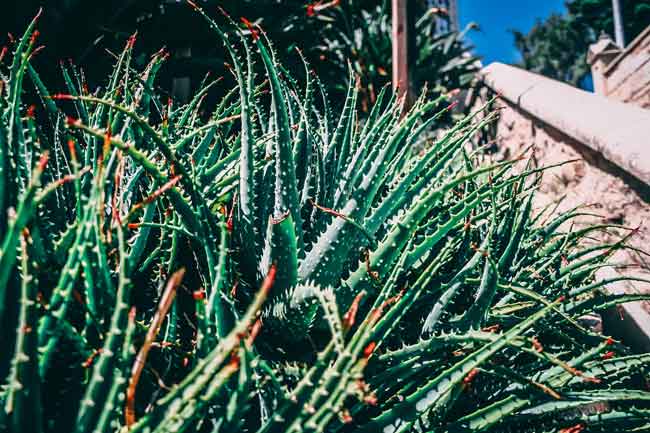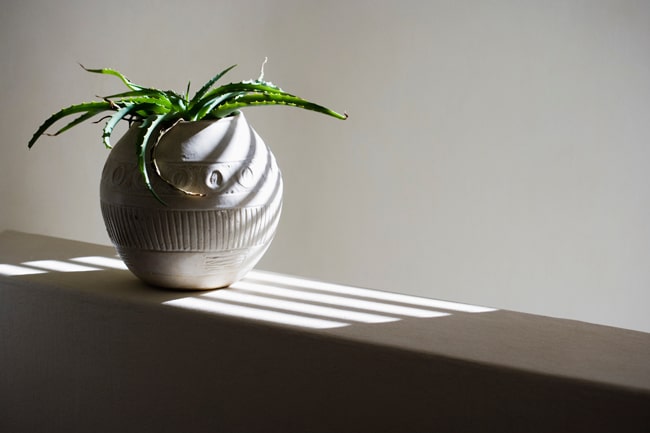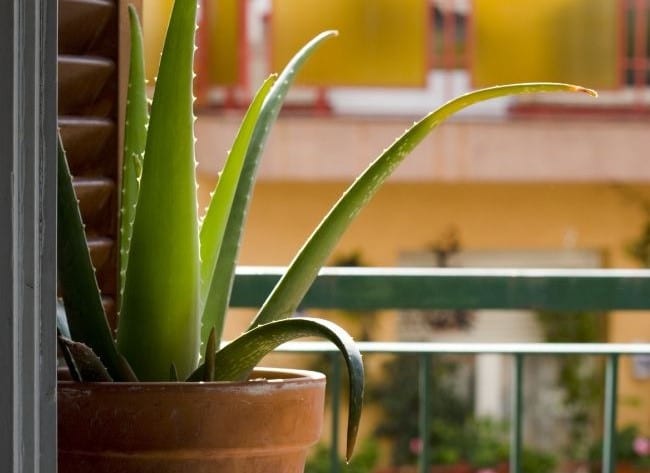Aloe vera plants are are very popular and attractive plants to have around the house or outdoors, not to mention the medicinal benefits of their leaves. They are generally easy to care for, but if you have found your aloe plant drooping, you are not alone. Thankfully, it’s not too hard to identify the problem and return your plant to health.
Why is my aloe plant drooping? An aloe plant with drooping leaves is a sign of one of a number of problems preventing it from thriving. Causes include overwatering, insufficient drainage, underwatering, disease, pests, heat shock, transplant stress, incorrect lighting or being pot bound.
Read on to learn how to identify what’s causing your aloe plant to droop and how to solve it.
Why Is My Aloe Plant Drooping?
Let’s look at the common reasons your aloe vera plant may be drooping. Not only are we going to tell you what to look for to figure out the cause of droop, but we will also tell you how to fix the situation.
Overwatering
Overwatering is the most common reason for a drooping aloe plant. If you notice the leaves begin to droop or wilt, we recommend you first investigate whether or not you are overwatering the plant.
One of the biggest hazards with overwatering is that the roots can become infected with fungus since fungus thrives in moisture. Check the roots for signs of rot and treat with a fungicide if it is evident.
Another sign of overwatering is the aloe leaves beginning to develop soak spots. The leaf will feel especially mushy and soggy due to the excess of moisture inside the plant.
Check the soil by placing your finger and feel for moisture. If the soil is wet, you might have been overwatering the aloe.
Of course, the best solution to this problem is to develop an effective watering strategy for your aloe plant. Ideally, you should wait until the soil has dried out completely before watering the plant again. When it’s dry, soak the soil. Then, wait until it has completely dried out to water again.
Read my step by step guide to fixing an overwatered plant if you’d like some more help.

It Lacks Drainage
As an extension of the overwatering issue, your aloe could be struggling and wilting because it lacks proper drainage. Ensure your aloe vera is planted in well draining soil and ensure that there is a drainage hole in the bottom of its pot. This allows the soil to dry out in between watering which is necessary to keep the plant healthy.
Underwatering
As you have seen, aloe plants have low water requirements, which is why overwatering is so common. That said, it is still possible to underwater the plant which commonly happens when aloe plants are neglected.
Underwatering is an issue for any plant. Not having enough water eventually leads to wilting and drooping leaves sooner or later. So, even though it’s uncommon with an aloe vera plant, underwatering is always possible.
As mentioned, when the soil of your aloe plant dries out completely, it is time to water. Soak the soil and be sure that there is a drainage hole at the bottom. Once the soil dries completely, it is time to water again.
Disease
Although usually quite low-maintenance, aloe plants can become infected with certain diseases. There are a few fungal and bacterial diseases to look out for. These include:
Aloe Rust: Aloe rust is a fungal disease that may occur if there is too much moisture in the environment or if the temperature is too cool. These conditions allow the fungus to thrive.
You can spot this disease by the emergence of yellow spots which develop into larger brown spots. Orange spores may also grow on the underside of the leaves. Typically, this disease limits itself but be sure that you are not overwatering the aloe and that it is is at an appropriate temperature.
Basal Stem Rot: Basal stem rot is a fungal infection that can occur when the plant is exposed to too much moisture. It is characterized by the base of the aloe turning brown and/or rotting.
This is quite serious to the health of the plant and may require trimming to save portions of the plant which have not been afflicted.
Bacterial Soft Rot: This is a bacterial infection that causes the leaves of the aloe plant to become watery and wilt. If your leaves are wilting and drooping, this is the most likely cause. Often, this is caused by overwatering as the excess moisture allows the bacteria to thrive. This disease is quite serious and often results in killing the aloe vera plant.
Generally, if your aloe vera plant is drooping or you suspect that it may be diseased, take quick action to identify the cause and try to rectify the problem. As you can see, it is often caused by overwatering the plant.
Pests
Aloe vera plants are susceptible to pest infestations. Often, these pests affect the leaves of the plant which can result in leaves that die or start to droop.
One of the most common aloe vera pests to look out for is aphids. Aphids suck sap from the leaves which can result in a dying, drooping leaf.
If you notice an aphid infestation on your aloe, treat it without delay with horticultural oil or neem oil. Alternatively, read more about the best ways to get rid of all common houseplant pests here.

Heat Shock
Another reason that an aloe vera plant can droop is due to varying temperatures. Aside from being kept in a temperature that is too high and too low, plants can undergo a temperature shock if they are quickly moved from one temperature to another.
Aloe vera plants should be kept between 60 and 75 °F (15 and 24 °C). While the aloe vera plant can live in temperatures outside of this range, this is the ideal range (especially if you are keeping the plant indoors). Also, be sure that the range does not vary too much as the plant does best under consistent temperatures.
Remember to avoid a temperature shock by gradually introducing your aloe plant to a new environment. Integrate it into the room at the new temperature for about an hour more each day to eliminate any shock that it may experience from this change.
Transplant Stress
Often, an aloe plant droops if it is in a container that is too small and does not allow the roots to grow big enough to support the plant. If this is the case, re-potting the aloe can be a solution. That said, repotting raises the new issue of transplant stress which can occur when the plant has difficulty rooting in the new environment.
To avoid transplant stress and to have your aloe in a pot of a suitable size, you aloe vera much be transplanted properly. Choose a new pot of an appropriate size – usually one size bigger than your last pot. Be sure to carefully remove the plant and replant in a similar environment to avoid any extra stress.
Overall, aloe plants are quite versatile and tough. As long as you are not introducing it to a very different environment, it should adapt to the change well.
Incorrect Lighting
An aloe vera plant should have about six hours of direct sunlight per day to thrive. This means if you are keeping the plant indoors, it should be placed near a window (preferably south-facing) where it can receive adequate sun. If it does not receive enough sun, you may see the plant droop and wilt.
Another important consideration with lighting is not to shock the plant by moving it into different lighting all at once. Instead, introduce the plant to about an hour more of sunlight per day, so that the plant can become accustomed. Otherwise, you run the risk of burning the aloe vera.

The Pot Is Too Small
This was mentioned above in the “transplant stress” section but since it can be independent of this issue, it deserves its own mention. If your aloe vera is in a pot that is too small, the roots may not have the space to grow big enough to support your plant. This can result in the plant becoming unstable and drooping.
It is imperative that your aloe vera is in an appropriately sized pot with proper holes for drainage. Ideally, when you first plant an aloe vera plant, the roots should take up about two-thirds of the pot. This gives them room to grow. When the time comes to repot the plant, go up one pot size at a time.
Conclusion
I hope I’ve given you all the tools you need to identify the reason for your aloe plant drooping, and shown you how to get your plant back to perfect health. As you have seen, there are many potential reasons that your aloe might droop.
Once you identify the problem, you can take swift action to rectify the issue. Aloe veras are tough and resilient plants, capable of surviving a lot. As long as you are observant and diligent, you can get your aloe thriving in no time.

